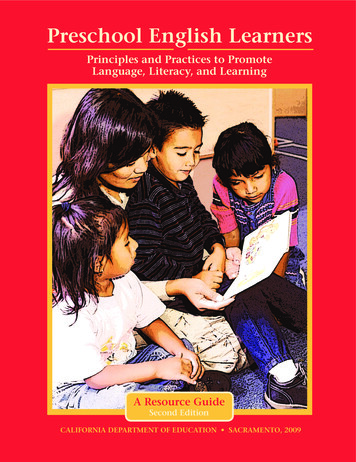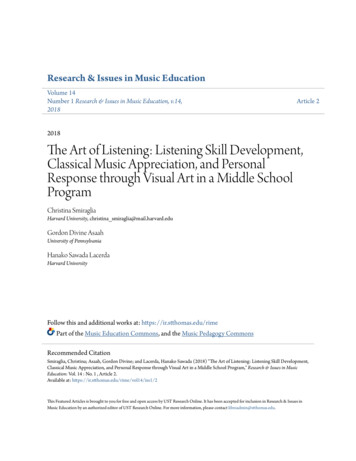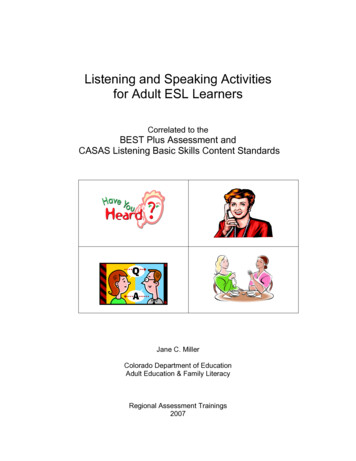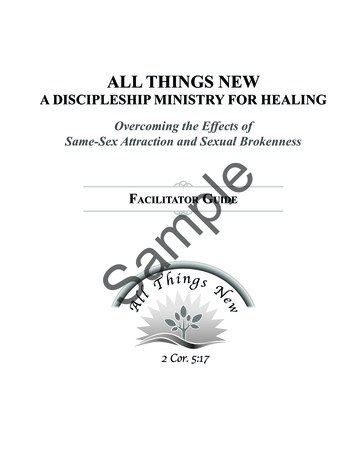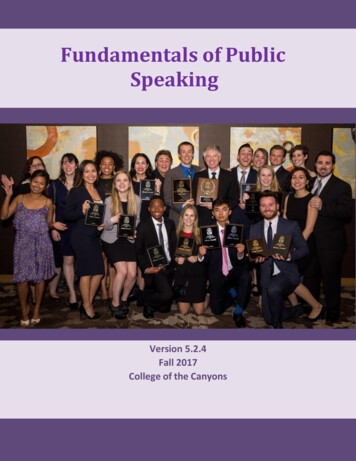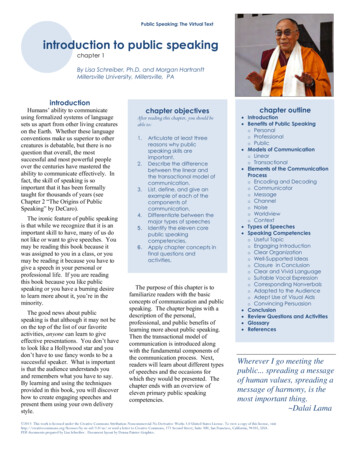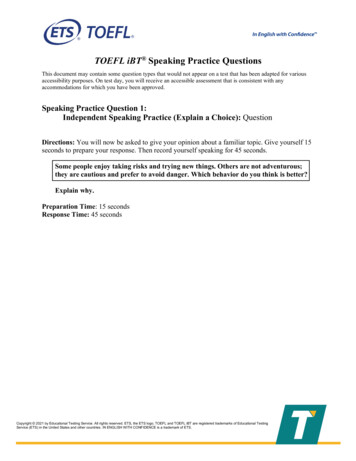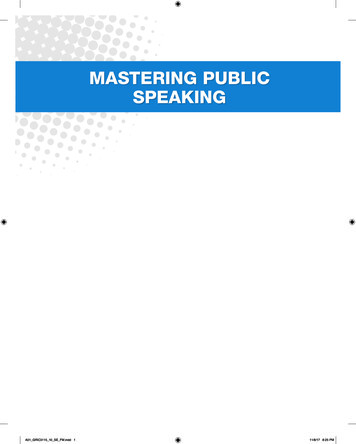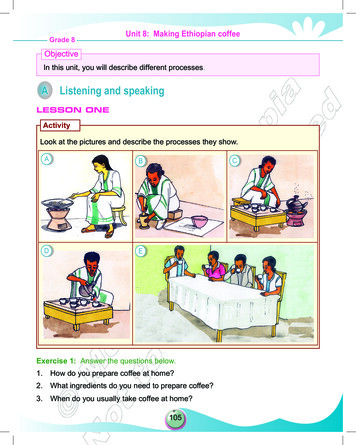
Transcription
Grade 8Unit 8: Making Ethiopian coffeeObjectiveIn this unit, you will describe different processes.AListening and speakingLESSON ONEActivityLook at the pictures and describe the processes they show.ABDECExercise 1: Answer the questions below.1. How do you prepare coffee at home?2. What ingredients do you need to prepare coffee?3. When do you usually take coffee at home?105
Unit 8: Making Ethiopian coffeeGrade 8Listening practiceExercise 2: Your teacher will read to you a short passage about the process ofmaking Ethiopian coffee. Listen carefully then answer these questions incomplete sentences.1. Who prepares the coffee in the family?2. Why do you think incense drifts in the room?3. Which accompaniments are offered to visitors while drinking Ethiopian coffee?4. From the passage, what shows that people love Ethiopian coffee?Exercise 3: Work with a partner. Form correct words from the letters given. The firstletter of each word has been given.nyoecerm ceremonyndtriotai t.fecofe c.notucry c.depuro p.secenin i.cocatemnpmonia a.LESSON TWOGrammarPresent simple passive tenseActivity 1In groups, describe the tea and coffee making processes in Ethiopia. Talk about anyother food or drink and how it is prepared.With a partner, read these sentences and discuss their similarities and differences.1. Ethiopians grow a lot of coffee.A lot of coffee is grown by Ethiopians.2. The workers wash the coffee beans before spreading them on a mat to dry.The coffee beans are washed before spreading them on a mat to dry.The words in bold are in the present simple passive tense.106
Unit 8: Making Ethiopian coffeeGrade 8Activity 2Think of any other processes before a final product is made. Examples: makinga pot; weaving a basket or making butter. Use sequencing words to describe theprocesses.Note: Sequencing words are words like first, next, then, before, after, finally, etc.Exercise: Rewrite these sentences starting with the words in bold.Example:The farmers irrigate the plantations in the dry season.The plantations are irrigated in the dry season.1. We produce the finest coffee in the region.2. She grows some herbs in the courtyard.3. He prepares lunch for the children when his wife is away.4. The machine churns milk within a short time.5. I wash the saucepans before filling them with water.6. They arrange the boxes late in the afternoon.7. The porters pick the tea leaves before lunch.8. The rollers crush the beans into powder.9. I supervise all the workers everyday.10. Students prepare the garden before they plant the seedlings.Grammar highlightThe passive voice is used instead of the active voice when the speaker isinterested mainly in the verb and the object. It is like turning the sentence upsidedown.107
Unit 8: Making Ethiopian coffeeGrade 8LESSON THREEUsing: . so (that) .Activity 1Read the different steps taken to process coffee and the process of producing bagsof coffee. How many steps are there?After coffee beans are harvested, they are spread on mats to dry. They are takento the factory where they are cleaned, roasted and ground into coffee. It is thenpackaged and distributed to selling points. Some of it is exported to other countries.Exercise 1: Answer these questions using .so that .1. Why are coffee beans dried?2. Why are gardens irrigated during the dry season?3. Why are the ingredients weighed?4. Why is coffee packed?5. Why are coffee beans roasted first?6. Why is coffee exported to other countries?Exercise 2: In groups of three, form more sentences using . so that .Grammar highlight.so that . is a conjunction. It is used to join sentences. so that .is also used in response to why questions.108
Unit 8: Making Ethiopian coffeeGrade 8LESSON FOURUsing: sequencing wordsRead the passageWith a partner, discuss the importance of using the words; first, next, then, after, andfinally in the passage.Making Ethiopian coffeeFirst the coffee beans are washed to get rid of dust particles. Next they are roastedon a flat pan.Then they are ground in a mortar by pounding with a pestle. By now the rich aromais filling the air around. After the coffee has been ground to powder, it is placed in ajetena, the coffee pot, with boiling water. Finally it is poured into little tea cups andserved to the people.The words first, next, then, finally, before and after are called sequencing words.Exercise:BUse the sequencing words to describe the process of preparing yourfavourite beverage.ReadingLESSON FIVEComprehensionActivityAnswer the questions. Work in groups.1. What are the various uses of water?2. Why is it important to drink clean water?Read the passage below.Making bottled mineral waterWater is important for the survival of all plant and animal life. It can be obtained fromstreams, rivers, ponds, lakes and oceans. These sources of water in turn are fedby rain and snow from the mountains. Water can also become a cause of health109
Unit 8: Making Ethiopian coffeeGrade 8problems especially when it is not clean. As a result, several bottling companies havebegun to sell and supply purified mineral water. It is served in eating places, at partiesand functions, business premises and some schools.The process of producing mineral water is quite complex. It requires clean water,numerous plastic bottles, sealable caps, huge boilers, purifying agents or detoxifiersand above all capital with which to assemble equipment.First, clean water is drawn from the water sources, usually a spring and poured inthe boilers to kill germs. The boiled water is left to cool after which it is mixed withdetoxifiers and then poured into clean plastic containers and bottles. Next they aresealed with caps to keep away germs that can contaminate the water.Finally, the bottled water is packed in cartons and sold to customers.Exercise: Answer the following questions based on the passage above.1. Why is water important?2. Name any other water source that has not been mentioned in the passage.3. List the requirements necessary for a water bottling plant.4. Why should the water be purified?5. Write the steps taken to produce clean bottled water.LESSON SIXJumbled passageExercise 1: Read the jumbled sentences. Rearrange them to explain the correctprocess of making bottled water.Process of making purified bottled mineral water1. Finally, the cartons are delivered to shops and other places for sell.2. It is then put into boilers where it is heated to above 100oC.3. The boiled water is then poured into coolers and detoxifiers are added to it.4. First, a water source is identified.5. Next, the bottles are packed into cartons.6. This temperature is meant to kill all the germs.110
Unit 8: Making Ethiopian coffeeGrade 87. It is then pumped to the factory.8. After adding detoxifiers and other chemicals, the water is packed in plastic bottles.9. The water source can be a river, spring, lake or even piped water.10. When the water reaches the factory, it is put into large containers for filtering.Exercise 2: Use a dictionary to find the meaning of these words.source filling cooler detoxifiersExercise 3: Use the words in your own sentences. State the importance of each stepin the water bottling process.LESSON SEVENPoemRead the poem below and answer the questions that follow.Ethiopia’s delicacyDelicious dishes; yummy yummyFrom Ethiopia; yummy yummyWat the national dish; yummy yummyA hot spicy stew; yummy yummyAccompanied by injera; yummy yummyMade from teff, smallest grainMade from teff flour, yummy yummy.Chicken wat, yummy yummyBeef wat, yummy yummyVegetable wat, yummy yummyBerbere hot spice, yummy yummyServed on top of injeraServed in a large large large mesobYummy yummy yummy yummy yummy.(Ivan Twine)111
Unit 8: Making Ethiopian coffeeExercise:Grade 8Answer these questions.1. What is Ethiopia’s traditional dish?2. What is served with this dish?3. List the different varieties of the national dish.4. How and with what is the food served?ActivityWrite your own poem about berbere, describing the ingredients and the preparationprocess. It should be at least one verse long.CWritingLESSON EIGHTMaking difo dabo / locally made breadActivity 1Describe these ingredients for making difo dabo. (wheat flour, salt, small pieces ofbread, yeast, water, spices, cooking oil and false banana).Exercise:Using the ingredients listed in the Activity above, write the method ofmaking difo dabo. In case you are not sure, ask your classmates or yourteacher.Activity 2In groups of three, list the ingredients of any dish of your choice. Discuss the cookingprocess or method.112
Grade 8Unit 8: Making Ethiopian coffeeLESSON NINEPoemActivity 1Describe what is happening in the picture.Exercise 1: Answer these questions.1. What ingredients are needed to make injera?2. What types of sauce and spices are served with injera?3. What is your favourite traditional meal?113
Unit 8: Making Ethiopian coffeeLearn the poem.Grade 8InjeraInjera is our staple breadTakes three days to prepareMade from cereal we call teffSoft and spongy with tangy tasteThin and looks like napkinWhen you see it the very first timeVery nutritious is our injeraRich in protein and mineral saltsCarbohydrates, iron and all.(Mercy Tim)Activity 2Write your own poem about injera, how it is served and eaten.Exercise 2: Complete the following passage with the words in the box.pieces, school, delivered, zipper, joined, buttons, uniform, measured, fabric, onWhen a school uniform is needed, the store is visited by my mother and I. Theis purchased and taken to the tailor. My height, waist and shoulders arein order to cut out patterns to sew. Next, the of the fabric are togetherby the tailor. Buttons are sewed the shirt after button holes are made. Finally,a is sewed on the skirt. The uniform is then to me so I can wear it onmy first day of .LESSON TENVocabulary networkActivityWork in groups of four. Discuss the foods that are processed from milk and meat.Write them in your exercise book.Exercise 1: Classify the foods. Match them with their general names.cheese, milk, greens, butter, beef, lamb, yoghurt, garlic, tomatoes,cabbage, apples, bananas, steak, beef, minced meat.114
Unit 8: Making Ethiopian coffeeGrade 8Fruits and vegetablesDairy productsMeat productsExercise 2: The following adjectives describe food. Match the ones in A with theiropposites in B.AB1. tastybitter2. sweetripe3. slimycrunchy4. rawbland5. uncookedcookedExercise 3: Make a vocabulary network using the example below about dairy productsand meat products.collectingwashingcuttingblendingadding flavourpackingExercise 4: How many vegetables do you know? List them down in your exercise book.Example: Describe a carrot.1. What does it taste like?2. What colour is a carrot?The information about the carrot can be presented in a table like this.VegetablecarrotJuicecarrot juiceTasteblandColourorangeExercise 5: Complete the following table for the fruit/vegetable words and formsentences to describe each ion fruitsPineappleLemon115
Unit 8: Making Ethiopian coffeeGrade 8LESSON ELEVENMaking a funny mask for a childActivity 1Write clear instructions on how to make a funny mask for a child.You will needpencilpaperscissorsthreadcrayonsExercise :What to dodrawfoldcutthreadcolourMake a mask based on the instructions you have written.Activity 2Work with a partner. Name and discuss the use of each item below in the Ethiopiancoffee making process.116
Present simple passive tense Activity 1 In groups, describe the tea and coffee making processes in Ethiopia. Talk about any other food or drink and how it is prepared. With a partner, read these sentences and discuss their similarities and differences. 1. Ethiopians grow a
